
Difference Between Lantus and Levemir. What to Choose?
The number of people who live with diabetes in the USA constitutes 11% of the overall number of citizens. This number is growing every year due to the aging of the nation and common weak health in people. This is why the variety of insulin and insulin-like products is getting bigger and bigger, and the new ones appear pretty often.
Today, we would like to talk more about two brands that are considered to be among the most popular ones – Levemir and Lantus. These two medications are pretty similar and have a lot in common; however, both of them have important dissimilarities patients should be aware of as well. Some people choose to learn all the needed information with the help of online pharmacies or their local stores. But, especially for our curious readers, we have prepared this article with all the needed details. Keep reading to know more info on the topic “Levemir vs. Lantus.”
Levemir for controlling blood sugar levels
 |
 |
Levemir is an analog to the human insulin in the body, and it is meant for helping to control blood glucose levels and move it to the fat, liver, or muscle tissues from the bloodstream. The dose has to be defined by the doctor depending on the patient’s health peculiarities, illnesses other than diabetes, lifestyle, and various other factors. Moreover, it is required to recalculate the amount of medication together with the medical professional if there were any changes in the patient’s health if there were a weight gain, changes in a diet or exercise routine, etc. Levemir is a medication for people with type 1 diabetes, as well as type 2 diabetes mellitus, with insulin detemir in its base. This type of injectable solution belongs to long-acting insulins and is mainly prescribed together with a short-acting one. The effect after the administration lasts for 24 hours and has its peak on the 8-10 hours after the injection was done. Depending on the recommendations from a health care provider, it can be used once or twice per day (once – in the evening, or twice – in the morning and before going to bed).
According to the recommendations from the professionals, the injection site should be changed after every drug administration. That is because otherwise, irritations, bumps, and allergic reactions may appear at the area of choice that is always used for this goal. Possible body areas include the abdomen, thighs, upper arm, and buttocks. A doctor should teach the patient a special administration technique before prescribing Levemir in order to avoid incorrect drug application and further possible complications.
Levemir insulin is available in the form of a vial, Flextouch pen, and cartridges (that should be inserted into the pen). The type of injection is defined depending on which one is more comfortable for the person, as well as which one will be easier to apply on their own. For overall comfort during the administration, the solution inside the cartridge or a vial should be at room temperature. The product doesn’t mean to be frozen, and if it was – it can’t be used; otherwise, the chances of serious complications would be very high.
Lantus for diabetes mellitus
 |
 |
 |
A brand-name drug Lantus with insulin glargine as the main active substance, belongs to the long-acting insulin as well as Levemir. It is a human insulin analog that was designed for blood sugar control, as well as controlling glucose levels in the body. With its help, the patient can forget about such problems as high blood sugar and all subsequent health problems.
This injectable solution may be prescribed for the treatment of those with type 2 diabetes and type 1 diabetes mellitus. This type of insulin products has to be applied once a day; specialists recommend choosing the same time for the administration to create a habit in the body. It doesn’t matter whether a person uses it in the morning or evening meal, as well as whether or not they had any activities before or after the injection.
As well as with Levemir, Lantus insulin injections dosage has to be recalculated in case any significant changes happened in the lives of adults. These changes include health problems, changes in training programs or diet, sudden weight loss or gain, etc.
All Lantus drugs with insulin glargine in the base come in the form of Solostar pens, cartridges for these pens, or vials. The type of injection is chosen together with a patient in order to pick something that would be the most comfortable for them. The rules of administration are the same as in Levemir, and the technique is the same as well.
Lantus vs. Levemir. Side effects and contraindications
As it was already mentioned, Levemir and Lantus have a lot in common. These analogs of human insulin are meant for those with type 1 and 2 diabetes and, like all medications for these issues, cause several side effects in those who use them. Here is a list of common symptoms that can appear after applying them, which are not dangerous at all and do not require the help of a medical professional:
- Hypoglycemia episodes (low blood sugar in people);
- Low blood potassium levels;
- An irregular heartbeat that is faster than usual;
- Unusual weakness or the feeling of constant tiredness;
- Frequent headaches or migraines;
- Increased appetite and feeling of hunger;
- Nausea;
- Muscle weakness and fatigue;
- Vision troubles (blurried vision);
- Injection site reactions (skin irritation, itching, rash, swelling, etc.).
These cannot cause a lot of damage to the patient’s health and should be gone quickly on their own. Medical advice and treatment from the professional are only required if any of the symptoms mentioned above become severe and cause serious discomfort or allergic reaction.
The most dangerous side effect after Levemir and Lantus is hypoglycemia. It may lead to such life-threatening complications as heart failure and diabetic coma. That is why patients should be taught to take care of this problem properly at home. First of all, the person can try to get blood sugar levels back to normal by themselves by eating something sweet, drinking a beverage that contains sugar, or taking a glucose pill (those can be purchased in any local pharmacy over the counter). If this method was not effective, it is better to contact a professional to get medical advice or diagnosis. The chances are, a glucagon injection may be needed, and it can be done only by a health care provider. Due to instructions, insulin injections cannot be administered if the level of sugar in the blood is low.
Speaking about contraindications, the list here will be pretty short. Drug information claims both medications can’t be used by those with allergies and hypersensitivity to any component of the drug, as well as people with diabetic ketoacidosis. Treatment with Levemir and Lantus is possible during pregnancy or lactation period; however, in this case, the dose should be calculated by the doctor so the baby is not affected by the medicine. If a patient has any questions about the drug interactions with other medications or supplements, it is recommended to have a consultation in a clinic to discuss this topic.
The main difference between Levemir and Lantus
There are not so many differences between Lantus and Levemir; they have a lot in common, and there are just a few factors that differ. Let’s have a closer look.
First of all, these drugs have different active substances in their base. Levemir includes insulin detemir, while Lantus is based on insulin glargine. All the drug information should be provided by a specialist, and only then a proper remedy should be picked according to the patient’s needs.
Next, the frequency of injections varies as well. Even though Levemir and Lantus are long-acting insulins, they should be administered with a different frequency. Levemir should usually be administered twice per day when Lantus cannot be applied more often than once per 24 hours.
Of course, do not forget about the time the medication is suitable for administering after the opening. Levemir vials or pens can be stored for 42 days after the opening, while Lantus is good only for 28 days (which is still long enough for a drug to be used completely).
One more important factor is that Levemir may be prescribed for kids from 2 years of age; the optimal age to start Lantus treatment is 6 years old. But still, they are always given in prescriptions together with short-acting insulin in order to achieve maximum activity and effectiveness.
As you can see, the list of dissimilarities is not very long. However, these medications still cannot be switched between one another or replaced unexpectedly.
Common features of the medications
We’ve discussed everything that is different between Lantus and Levemir, so now let’s switch to the similarities between these two brands. There is more in common than it is different, but we will concentrate on the main aspects.
These drugs are long-acting insulins, analogs to the human insulin that is produced naturally by the body. Both are brand-name medications that can only be prescribed by the doctor and cannot be bought over the counter. Also, they can be used for the treatment of diabetes mellitus in adults and children after a specialist prescribes a proper dosage of a remedy.
The storing conditions are also the same. Levemir and Lantus should be stored in a refrigerator at a temperature from 2 to 8°C, and cannot be frozen because it may lead to serious complications after the administration. The drug should be a room temperature in order to be administered. Opened vials have to be kept in a dark place, away from direct sunlight and heat sources at temperatures not higher than 25°C. They should also be hidden carefully from children. And, as with any medication, Levemir and Lantus can’t be used by a patient after the expiration date mentioned on the packaging.
To learn more about the similarities, you may talk to a professional specialist. They can explain all the aspects mentioned above in more detail.
Final word
Levemir and Lantus are both outstanding and effective medications that help a lot in regulating blood sugar levels in people with diabetes mellitus. The exact type can only be defined by a professional depending on the person’s health conditions, type of diabetes, lifestyle, and other factors.
Nowadays, it is possible to purchase these remedies in online pharmacies, and they will be delivered directly to your address quickly and safely; however, local pharmacies are still an option for those who find it more comfortable. Just do not forget that Lantus and Levemir require a valid prescription from a health care provider. That is all for today. Thank you for reading, and we’ll see you in our next article!
